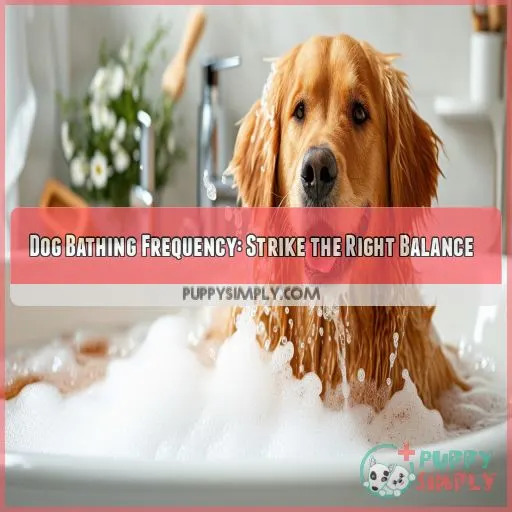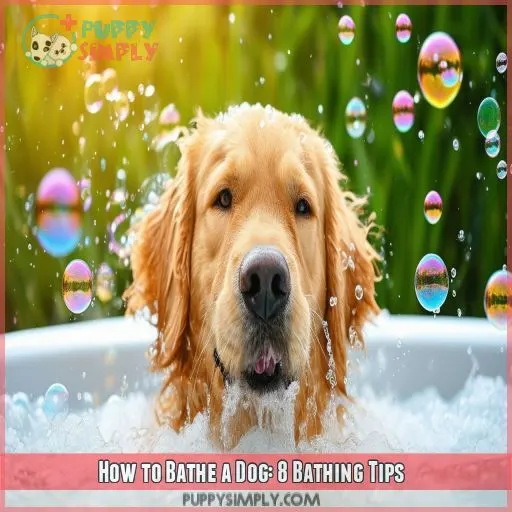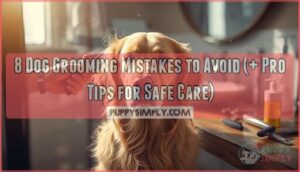This site is supported by our readers. We may earn a commission, at no cost to you, if you purchase through links.

Confidence: 90%
Table Of Contents
- Key Takeaways
- How Often Should I Bathe My Dog?
- 9 Benefits of Bathing Your Dog
- How to Bathe a Dog: 8 Bathing Tips
- Can I Give a Dog a Bath Without Water?
- How Often to Bathe Puppy Dogs
- Frequently Asked Questions (FAQs)
- How frequently should you wash your dog?
- Can I bathe my dog every once a week?
- Can I rinse my dog with water every day?
- How often can you bathe a dog with skin issues?
- Are there any home alternatives to dog shampoo?
- Is it safe to bathe a blind dog alone?
- How does weather affect optimal bathing schedules?
- Can baking soda substitute for dog shampoo in emergencies?
- Does a change in diet impact required bathing frequency?
- Conclusion
Key Takeaways
- Adjust dog bathing frequency based on breed, coat type, and activity level, like tuning an instrument for a perfect melody.
- Beware of overbathing that may leave your furry friend’s skin feeling drier than a desert in a heatwave.
- Consider health conditions like skin sensitivities or infections when determining your dog’s bathing routine to keep them clean and comfortable.
- Finding the right balance in dog washing is like solving a puzzle – tailor the bathing schedule to your canine companion for a harmonious result.
How Often Should I Bathe My Dog?
To determine how often you should bathe your dog, consider its breed, coat type, and lifestyle. Tools like the Bone Dry Pet Grooming Towel X-Large and the Aquapaw Dog Bath Brush Pro can make the process easier and more effective.
1. Bone Dry Pet Grooming Towel X-Large
The Bone Dry Pet Grooming Towel X-Large makes post-bathtime a breeze!
This ultra-soft, lightweight microfiber towel absorbs water quickly, reducing wet pet mess.
Its generous size fits small, medium, and large dogs and cats, perfect for:
- Grooming
- Travel
- Protecting surfaces
At 80% polyester and 20% polyester microfiber, it’s both strong and gentle on delicate fur.
Simply toss it in the washing machine for easy cleanup – handy for repeat uses between washes.
Best For: The Bone Dry Pet Grooming Towel X-Large is best for pet owners with small, medium, and large dogs and cats, particularly those who value ease of grooming and post-bath time cleaning.
- Made from ultrasoft, quick-absorbent material that reduces wet pet mess
- Versatile enough for grooming, travel, surface protection, and even use as a pet blanket or car seat cover
- Machine washable for easy cleanup
- May not be suitable for extremely large or heavy pets due to its stated size of 41"L x 23.5"W
- Some users may find the need to frequently clean the towel inconvenient
- Potential wear and tear over time with repeated use and washing
2. Aquapaw Dog Bath Brush Pro
Enjoy effortless grooming with the Aquapaw Dog Bath Brush Pro.
This 100% silicone marvel combines:
- A scrubber
- A bathing brush
- A massager
- A shower
It offers a gentle yet thorough cleaning experience for your pet’s coat and skin.
Featuring adjustable water pressure, this versatile tool connects to your shower or garden hose, saving time and minimizing water usage. Ideal for pets with long, medium, or short hair, it makes bathtime a breeze.
Keep in mind that suitable bathing frequency depends on coat type, health, and lifestyle – find the right balance for your distinct pal.
Best For: Pet owners with dogs of all coat types and lengths looking for a multifunctional, water-efficient grooming tool.
- Combines scrubbing, bathing, massaging, and shower functions in one device.
- Offers adjustable water pressure and connects to both shower and garden hoses.
- Suitable for pets with long, medium, or short hair, simplifying the bathing process.
- May require additional metal washers for proper installation.
- Some users have reported issues with water leakage at the connection point.
- The hook for attaching the Aquapaw to the diverter might not fit securely.
9 Benefits of Bathing Your Dog
Bathing your dog regularly offers numerous benefits, from removing dirt and odors to spotting health issues early. Considering factors like coat type, health, and lifestyle helps you determine the right bathing schedule to keep your dog clean and healthy.
Adapt Bathing To Coat Types
=================================================================================================
- Coat type matters: Different coats have varying maintenance requirements.
- Preserve those oils: Overbathing can strip natural oils, so choose the right frequency for your pooch’s coat type.
- Weather adaptability: Winter coats need fewer suds sessions; summer cuts might crave cool showers.
- Skin sensitivity: Opt for dog-specific shampoo, medicated if needed, to keep sensitive skin smiling.
Impact Of Health On Bathing
Sure, here’s how health impacts bathing for your dog! Some health conditions mean adjustments to your dog’s bathing routine are required. For instance, dogs dealing with skin issues, sensitivities, or infections may need more regular baths with veterinary-prescribed cleansers. On the other hand, dogs with delicate skin could profit from less frequent washing utilizing gentle, hypoallergenic solutions. It’s always wise to consult your vet to find the correct equilibrium.
Below is a quick overview showing the relationship between health conditions and bathing frequency:
| Health Condition | Bathing Frequency |
|---|---|
| Skin Issues | Might Enhance |
| Sensitivities | Could Alter |
| Infections | Might Increase |
| Delicate Skin | Could Lessen |
Every dog holds uniqueness, making individualized variations critical depending on their medical situation.
Balanced Dog Bath Schedule
Creating a balanced dog bath schedule begins with comprehending your pet’s unique needs. Take into account coat types – long-haired varieties may require bi-weekly baths, whereas short-haired ones can manage monthly. Evaluate activity levels; highly active dogs demand more regular bathing to stay clean. Don’t overlook allergies! They mandate personalized bath schedules and products. Finally, factor in flea prevention strategies in your routine. Remember, constancy plays a pivotal role in preserving not only a healthy dog but also a tranquil state of mind!
- Coat types: adjust bathing according to distinct demands
- Activity levels: influence suitable intervals
- Allergies: special accommodations needed
- Flea prevention: necessary aspect in dynamic lifestyles
How to Bathe a Dog: 8 Bathing Tips
Now that you’re well-versed with the advantages of washing your canine companion, let’s proceed to cover how to do it right. Below are eight strategies for bathing your dog:
Always examine your dog’s skin post-bath for indicators of discomfort or irregularities. Should any concerns arise, consult your veterinarian immediately. Bear in mind, every dog has distinct requirements, hence adapt these actions based on your furry friend’s individual traits and preferences.
Can I Give a Dog a Bath Without Water?
Let’s explore waterless dog baths. You may wonder whether cleaning your dog without water is feasible – indeed, it is! Waterless dog shampoos come in various forms like foam sprays, powder shampoos, and dry foam sprays. Perfect for new dog owners or those needing a swift clean-up solution, these products benefit dogs with delicate skin since they usually have fewer chemicals and fragrances compared to conventional shampoos.
Keep in mind that certain dogs might dislike the feel of these items, so gradually introduce them to observe your pet’s reaction. Also, watch out for leftover residue which can trigger allergies or irritation. Choosing a waterless shampoo means considering your dog’s likes, their lifestyle, and any present skin issues. Despite omitting water, don’t forget to work the product through your dog’s fur completely for best results. Enjoy bath time with your furry companion!
How Often to Bathe Puppy Dogs
- Age & Bathing: A younger pup’s sensitive skin means fewer baths are better. Start off with biweekly or monthly baths, gradually increasing as they grow older.
- Size & Bathing: Smaller pups might need extra care during bath time due to their size. Make sure to support their body properly and use a mild shampoo.
- Shampoo Choices: Opt for gentle, tear-free formulas designed specifically for puppies. Their delicate skin requires extra love and attention.
- Post-Bath Care: After bathing, wrap your pup in a cozy towel and gently pat them dry. Remember, puppies lose heat quickly, so keep them warm to prevent chills.
- Socializing Through Baths: Giving baths can be an excellent opportunity to bond with your new companion and help them get accustomed to handling.
Frequently Asked Questions (FAQs)
How frequently should you wash your dog?
To strike a balance, bathe your furry friend as often as they need, but not too much; overbathing can harm their skin. For many dogs, every three to four weeks hits the sweet spot, yet adjust based on their unique traits and lifestyle.
Can I bathe my dog every once a week?
Yes, you can bathe your dog every week, especially if they’re active or have a specific coat type requiring frequent care. Just use a gentle shampoo to avoid drying out their skin and coat.
Can I rinse my dog with water every day?
You can rinse your dog with water daily, but avoid using shampoo more than once a week. This helps maintain their skin’s natural oils without over-drying. Consult your vet for personalized bathing recommendations.
How often can you bathe a dog with skin issues?
Did you know over 56% of pet owners don’t bathe their dogs often enough? If your dog has skin issues, bathe them every 1-2 weeks with a gentle, medicated shampoo, and consult your vet for personalized advice.
Are there any home alternatives to dog shampoo?
You can use diluted baby shampoo as a gentle alternative to dog shampoo. Another option is a homemade mix of water, apple cider vinegar, and a touch of mild dish soap for a simple, effective clean.
Is it safe to bathe a blind dog alone?
Bathing a blind dog alone can be risky. They rely heavily on their sense of touch and hearing, so sudden movements or sounds can be unsettling. Having another person helps guarantee their safety and comfort.
How does weather affect optimal bathing schedules?
Warm weather may necessitate more frequent bathing for your dog due to increased dirt, odors, and shedding. Conversely, colder weather can reduce the need for baths as your dog’s coat naturally protects against grime and moisture.
Can baking soda substitute for dog shampoo in emergencies?
Sure, in a pinch, you can sprinkle baking soda on your dog’s coat to absorb odors and dirt. Gently brush it through, avoiding eyes and ears. It’s not a full replacement, but it works temporarily.
Does a change in diet impact required bathing frequency?
A change in your dog’s diet can impact their bathing frequency. Improved nutrition can lead to healthier skin and coat, reducing the need for frequent baths, while certain foods might increase skin oiliness or odors, necessitating more baths.
Conclusion
Finding the perfect balance in dog washing and bathing frequency is like striking a chord in a symphony.
By tuning your routine to your dog’s breed, coat type, and activity level, you’ll maintain their cleanliness and skin health.
Regular baths prevent odors and potential skin issues, while keeping your pet comfortable and happy.
With the right tools and understanding, you can make certain your dog’s bathing routine meets their unique needs, enhancing their overall well-being.










